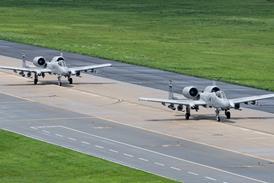Paul Lewis/WASHINGTON DC

Lockheed Martin and Boeing have unveiled further changes to their respective planned Joint Fighter Aircraft (JSF) design submissions, as the two competing teams work to cut weight and incorporate evolving changes to operational requirements for the preferred weapon systems concept (PWSC).
Among the more visible changes to the final Lockheed Martin-led 230-5 design iteration is an enlarged main wing to meet a higher 9g stress requirement. The size of the wing on the short take-off and vertical landing (STOVL) and conventional take-off and landing (CTOL) versions has been increased from 38.3m² (412ft²) to 42.7m², while the wing on the US Navy's carrier variant (CV) has grown from 55.7m² to 57.6m².
The other main change to 230-5 is a redesign of the lift-fan nozzle from a D-shape extendible duct to a venetian-blind-type vane box. "We've done a lot of windtunnel testing and we still get the vector angle range we need to deploy the lift fan. Besides making it more simplistic, there is a lot of weight coming out," says Fran Ketter, Lockheed Martin JSF propulsion system integration manager.
Another previously unknown change to the earlier 230-3 iteration has been the incorporation of smaller, lighter air inlets. They have been redesigned from a two- to a three-sided configuration for higher angle-of-attack performance and reduced in length by about 0.76m (2.5ft).
Boeing has revealed significant changes to the direct-lift STOVL version of its penultimate 374 design to meet the critical 1,810kg (4,000lb) bring-back-weight requirement.
It has shaved 0.76m off the wingspan and removed 0.45m from the fuselage aft of the wingbox from the proposed US Marine Corps and Royal Navy PWSC. "We've made tremendous progress on bring-back capability over the last six months. We've improved our performance by more than 1,500lb and are about where we need to be," says Dennis Muilenburg, Boeing JSF weapon system director.
The overall dimensions of the now larger Boeing CTOL and CV aircraft have not changed. Changes common to all three versions include a 5% larger vertical stabiliser, a 5% smaller horizontal tailplane and extended straight edge wing tips to enhance manoeuvre, structural integrity and stealth. Two side inlets are added to the upper forebody to provide added cockpit and system cooling.
Source: Flight International























